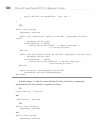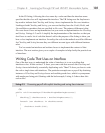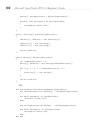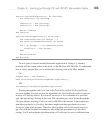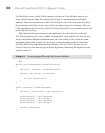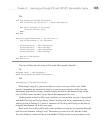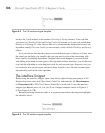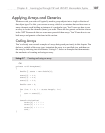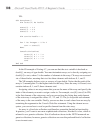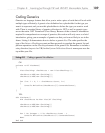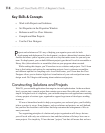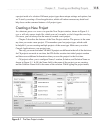
108 Microsoft Visual Studio 2010: A Beginner’s Guide
VB:
Sub ArrayDemo()
Dim stats(2) As Double
stats(0) = 1.1
stats(1) = 2.2
stats(2) = 3.3
Dim sum As Double = 0
For i As Integer = 0 To 2
sum += stats(i)
Next
Console.WriteLine(
stats(0) & " + " &
stats(1) & " + " &
stats(2) & " = " &
sum)
End Sub
In the C# example of Listing 4-7, you can see that the stats variable is declared as
double[], an array of type double. You must instantiate arrays, as is done by assigning new
double[3] to stats, where 3 is the number of elements in the array. C# arrays are accessed
via a 0-based index, meaning that stats has three elements with indexes 0, 1, and 2.
The VB example declares stats as an array of type double. Notice that the rank of the
array is 2, meaning that 2 is the highest index in the array. Since the array is 0-based, stats
contains indexes 0, 1, and 2; three elements total.
Assigning values to an array means that you use the name of the array and specify the
index of the element you want to assign a value to. For example, stats[0] (stats(0) in VB)
is the first element of the stats array, and you can see from the listing how each element
of the stats array is assigned the values 1.1, 2.2, and 3.3. The for loop adds each element
of the array to the sum variable. Finally, you can see how to read values from an array by
examining the argument to the Console.WriteLine statement. Using the element access
syntax, you can see how to read a specific element from the stats array.
An array is a fixed-size collection, and therefore somewhat limited in functionality.
In practice, you’ll want to use more sophisticated collections, like the List class, which is
referred to as a generic collection. Not all collection classes in the .NET Framework are
generic collections; however, generic collections are now the preferred kind of collection
to use in most cases.



